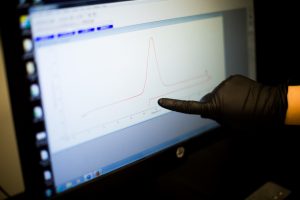


DSC is a popular research technique used to study phase changes in materials. The amount of energy necessary to raise or lower the temperature of a sample by one degree is measured, and compared to an empty Al reference pan. Phase changes such as melting and crystallization can be seen as peaks (either endothermic or exothermic) in the DSC curve. The shape of the DSC curve varies greatly with material; for example, metals tend to have a sharp, narrow peak, while polymers are much broader. DSC is used to study a variety of materials, and can even be used to generate portions of a phase diagram. In this experiment, students investigate the heat capacity of two materials (how much energy it takes to increase the temperature by one degree without changing phase), and then study the latent heat (how much energy is needed to change phase at a constant temperature) of several materials. Rate effects are also studied by increasing/decreasing the heating and cooling rate used. Each material studied is considered in terms of energy storage applications.
Equipment Used
- PerkinElmer DSC (Jade or DSC 4000 models), with accompanying Pyris Manager software
- Al DSC pans and lids
- Crimper for DSC pans
- Analytical balance
Materials Tested
- Graphite (heat capacity)
- Silicon carbide (heat capacity)
- Bismuth (latent heat)
- Stearic acid (latent heat)
- Magnesium chloride hexahydrate (latent heat)
- Paraffin wax (latent heat)
- Paraffin wax components, such as eicosane, tricosane, etc (latent heat)